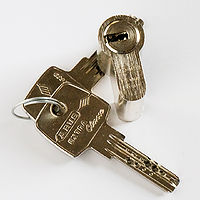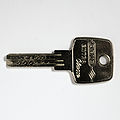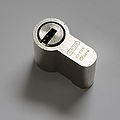ABUS EC700: Difference between revisions
m (→{{PAGENAME}}: clarity) |
m (→{{PAGENAME}}: add disassembly instructions) |
||
| Line 26: | Line 26: | ||
ABUS utilizes a variety of security features to deter picking. At least two of the brass driver pins in the bottom row are spooled [[security pin]]s. Standard pins have tapered edges to reduce feedback. Multiple rows of opposing pins are common in [[high pin count]] locks and the EC700 adds another obstacle through a less-common implementation of this design. The four pins of the top row are directly opposite pins from the bottom row and touch in the middle when the key is not present. This configuration complicates picking because the force of the much stronger bottom springs [[overset]]s the pins of the top row. Picking attacks tend to rely on dedicated tools to work around this initial state. The [[Kale Kilit 164 BNE]] is another lock that shares this design feature. | ABUS utilizes a variety of security features to deter picking. At least two of the brass driver pins in the bottom row are spooled [[security pin]]s. Standard pins have tapered edges to reduce feedback. Multiple rows of opposing pins are common in [[high pin count]] locks and the EC700 adds another obstacle through a less-common implementation of this design. The four pins of the top row are directly opposite pins from the bottom row and touch in the middle when the key is not present. This configuration complicates picking because the force of the much stronger bottom springs [[overset]]s the pins of the top row. Picking attacks tend to rely on dedicated tools to work around this initial state. The [[Kale Kilit 164 BNE]] is another lock that shares this design feature. | ||
== Disassembly instructions == | |||
To disassemble a double euro cylinder, use of a pinning shoe is the preferred method. | |||
Other possibility is to use a segmented follower, but that requires that both cores are pulled out a bit to allow a cam removal. Then a core should be rotated to approximately 4:30 or 7:30 o'clock position (135 degrees either clockwise or anti-clockwise) to prevent driver entering a gaps for the cam clutch. Then a segmented follower can be used to remove the core. | |||
== Gallery == | == Gallery == | ||
Revision as of 05:32, 2 December 2022
ABUS EC700
| ABUS EC700 | |
 | |
| Name | ABUS EC700 |
|---|---|
| Manufacturer | ABUS |
| Lock Type | Cylinder |
| Lock Design | Pin-tumbler, Dimple |
| Specifications | |
| # of Components | 10 |
| Component Type | Pin-tumbler |
The Extra Classe 700, commonly referred to by its model number EC700, is a door cylinder lock made by ABUS. It is a dimple lock that uses the flat side of the key blade as a bitting area.
Principles of operation
The ABUS EC700 utilizes dimple keys but functions the same as a standard pin-tumbler lock. The key is bitted on both sides of the blade and is reversible. The lock uses ten chambers for pin-tumbler stacks. Four chambers in a row on the top of the lock and six chambers in a row on the bottom. Each of those chambers contains a set of key pin, driver, and spring. To open the lock, all ten pin-tumblers must be aligned at the shear line. (See also Pin-tumbler, Principles of Operation)
ABUS utilizes a variety of security features to deter picking. At least two of the brass driver pins in the bottom row are spooled security pins. Standard pins have tapered edges to reduce feedback. Multiple rows of opposing pins are common in high pin count locks and the EC700 adds another obstacle through a less-common implementation of this design. The four pins of the top row are directly opposite pins from the bottom row and touch in the middle when the key is not present. This configuration complicates picking because the force of the much stronger bottom springs oversets the pins of the top row. Picking attacks tend to rely on dedicated tools to work around this initial state. The Kale Kilit 164 BNE is another lock that shares this design feature.
Disassembly instructions
To disassemble a double euro cylinder, use of a pinning shoe is the preferred method.
Other possibility is to use a segmented follower, but that requires that both cores are pulled out a bit to allow a cam removal. Then a core should be rotated to approximately 4:30 or 7:30 o'clock position (135 degrees either clockwise or anti-clockwise) to prevent driver entering a gaps for the cam clutch. Then a segmented follower can be used to remove the core.
Gallery
See also
| This article is a stub. You can help Lockwiki by expanding it. |


